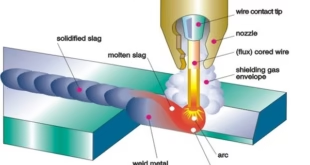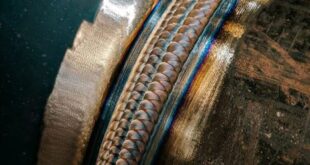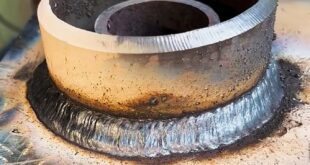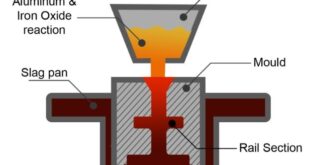Submerged Arc Welding
Introduction
Submerged Arc Welding (SAW) is a type of welding process that is widely used in various industrial applications for welding thicker sections of metal. The process involves the use of a consumable electrode, a flux that creates a protective shield around the weld, and a welding power source.
Definition:
Submerged Arc Welding is a welding process in which the arc is generated between the electrode and the workpiece and is shielded by a granular flux that is spread over the surface of the weld. The flux creates a protective barrier around the weld, shielding it from atmospheric contamination and improving the quality of the weld.
History: Submerged Arc Welding was first developed in the 1930s and has since become an important welding process in various industries. It was originally used for welding large structures, such as shipbuilding and heavy equipment manufacturing, and has since been adapted for use in other applications, such as construction and pipeline fabrication.
Comparison to other welding methods:
Submerged Arc Welding is typically faster than other welding methods, such as Gas Tungsten Arc Welding (GTAW) and Gas Metal Arc Welding (GMAW), and can produce high-quality welds with a minimum of post-weld cleaning. However, SAW requires more complex equipment and a higher degree of operator skill compared to other welding methods, and is typically more expensive.

Basic Principles of SAW
Submerged Arc Welding (SAW) is a welding method that uses a consumable electrode and a granulated flux to produce a high-quality weld. The basic principles of SAW are as follows:
- Consumable electrode: The consumable electrode is a wire that is fed into the welding area and melted to form the weld. The electrode is typically made of a wire with a flux coating that provides shielding and slag protection for the weld.
- Flux: The flux is a granulated material that is placed on top of the workpiece to provide shielding for the weld. The flux also provides a protective layer for the weld, preventing contamination from the surrounding atmosphere.
- Arc formation: The electrode is connected to a power source, and an electric arc is formed between the electrode and the workpiece. The arc is submerged under the flux, providing shielding from the surrounding atmosphere.
- Welding: The electrode is melted and fuses with the workpiece to form the weld. The flux provides a protective layer for the weld, allowing it to cool and solidify.
- Slag removal: After the weld has cooled, the slag, which is formed from the flux, is removed, revealing a high-quality weld. The slag is removed using a slag hammer or other slag removal tool.
Advantages of SAW
Submerged Arc Welding (SAW) offers several advantages, including:
- High-quality welds: SAW produces high-quality welds with superior penetration and fusion of the workpiece.
- Increased efficiency and productivity: SAW has a higher deposition rate compared to other welding methods, allowing for increased efficiency and productivity.
- Ability to handle large welding jobs: SAW is capable of welding large, heavy components and structures, making it ideal for large welding jobs.
- Low levels of distortion: SAW produces minimal levels of distortion, reducing the need for post-weld treatment.
- Versatility: SAW can be used with a wide range of welding consumables, making it versatile for different applications.
- Cost-effective: Although the initial investment in SAW equipment may be higher than other welding methods, SAW can be more cost-effective in the long run due to its increased efficiency and productivity.
- High deposition rates: SAW has a high deposition rate, which allows for a faster welding speed compared to other methods.
Disadvantages of SAW
Submerged Arc Welding (SAW) also has some disadvantages, including:
- Complex setup and equipment requirements: SAW requires specialized equipment and a complex setup, making it more difficult and time-consuming compared to other welding methods.
- Need for highly skilled operators: SAW requires highly skilled operators to produce high-quality welds, which can be challenging to find and maintain.
- Higher cost compared to other welding methods: The initial investment in SAW equipment can be higher compared to other welding methods.
- Limited to flat or near-flat surfaces: SAW is limited to welding flat or near-flat surfaces, making it unsuitable for welding complex or irregular shapes.
- Slower welding speed compared to other methods: SAW has a slower welding speed compared to other methods, such as gas tungsten arc welding (GTAW) and gas metal arc welding (GMAW).
- Poor penetration on thicker materials: SAW may struggle with penetration on thicker materials, making it unsuitable for welding thicker sections.
- Generates significant amounts of heat and friction: SAW generates significant amounts of heat and friction, causing warping and distortion of the workpiece.
Applications of SAW
Submerged Arc Welding (SAW) is used in various industries and applications, including:
- Construction and fabrication: used in welding large steel structures, bridges, and shipbuilding.
- Pipe welding: commonly used for welding pipes in the oil and gas industry.
- Pressure vessel fabrication: used for welding large boilers, tanks, and heat exchangers.
- Mining and heavy equipment: used for welding large mining equipment, such as draglines, shovels, and loaders.
- Automotive and transportation: used in welding truck frames, trailers, and railway cars.
- Maintenance and repair: used for repairing heavy equipment and structures.
- Other applications include the aerospace industry, power generation, and general manufacturing.
Safety Considerations for SAW
Submerged Arc Welding (SAW) involves several hazards that need to be considered to ensure a safe working environment. Some safety considerations for SAW include:
- Welding fumes: SAW generates fumes that can be harmful if inhaled, so proper ventilation and air filtration systems should be used.
- Radiant energy: SAW produces intense radiant energy that can cause eye damage and skin burns, so adequate protective equipment, such as welding helmets and gloves, should be worn.
- Burns: SAW generates significant amounts of heat, which can cause burns to the skin and clothing, so protective clothing, such as flame-resistant garments, should be worn.
- Electrical shock: SAW uses electrical energy, so care should be taken to avoid electrical shock, such as by using dry gloves and avoiding contact with conductive objects.
- Fire: SAW produces intense heat and sparks, which can ignite flammable materials, so the welding area should be kept free of any combustible materials.
- Welding noise: SAW generates loud noise, so hearing protection should be worn.
- Proper training: All operators and personnel working with SAW equipment should receive proper training on the safe and effective use of the equipment.
FAQs
What is the limitation for submerged arc welding process?
Limitations for Submerged Arc Welding process: The main limitations include complex setup and equipment requirements, the need for highly skilled operators, and a higher cost compared to other welding methods.
Is pressure required for submerged arc welding?
Pressure is not required for Submerged Arc Welding.
Why is the quality of submerged arc welding very good?
The quality of Submerged Arc Welding is very good due to the continuous and uniform heating of the metal and the use of a protective flux that helps prevent oxidation and contamination of the weld.
Which type of electrode is used in submerged arc welding?
Submerged Arc Welding typically uses a flux-coated electrode.
Why flux is used in submerged arc welding?
Flux is used in Submerged Arc Welding to create a protective barrier around the weld, shielding it from atmospheric contamination and improving the quality of the weld.
Is submerged arc welding AC or DC?
Submerged Arc Welding can be performed with both AC and DC power sources.
What is the minimum thickness for submerged arc welding?
There is no minimum thickness requirement for Submerged Arc Welding, but the process is typically used for welding thicker sections of metal.
Is submerged arc welding is suitable for every application?
Submerged Arc Welding is not suitable for every application, but it is commonly used for large welding jobs in industries such as shipbuilding, heavy equipment manufacturing, and construction.
What equipment is used in submerged arc welding?
Equipment used in Submerged Arc Welding includes a welding power source, welding wire, flux, and a welding head.
What is the other name of submerged arc welding?
Submerged Arc Welding is also known as Submerged Arc Technology (SAT).
Can submerged arc welding be done underwater?
Submerged Arc Welding can be performed underwater with special equipment and techniques.
Is submerged arc welding automatic?
Submerged Arc Welding can be semi-automatic or automatic, depending on the specific requirements of the job and the equipment used.
Conclusion
Submerged Arc Welding (SAW) is a welding method that has become increasingly important in modern welding practices due to its high efficiency, productivity, and ability to produce high-quality welds. SAW is widely used in various industries, including construction, fabrication, pipe welding, pressure vessel fabrication, and more. However, SAW also has some disadvantages, such as complex setup and equipment requirements, the need for highly skilled operators, and a higher cost compared to other welding methods. Additionally, there are several safety considerations that must be taken into account, such as welding fumes, radiant energy, and fire hazards.
 Welding of Welders All about Welding and Welders
Welding of Welders All about Welding and Welders



